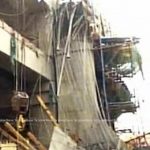Chowk Kotwali
From Being a Nawab’s House to a Modernized Police Station
During the Mughal rule, the Chowks of cities were central places of marketing and glamour. Like most of the places, which have Mughal footprint- Chandni Chowk (Delhi), Moti Chowk (Jaipur) and Manik Chowk (Jhansi)- Lucknow also has a Chowk area. The Lucknow Chowk market, which extends from the Akbari Darwaza to the Gol Darwaza, was considered much superior to the other markets in the city. The old part of the city or the Chowk area specifically has the mark of the Nawab’s existence in the city.
Chowk Kotwali, with a history of more than 110 years, will now be preserved as the heritage site in form of a modernized police station in the city. The structure underwent renovation after the launch of the Unnayan project by Uttar Pradesh Chief Minister Akhilesh Yadav in January 2015. Under the Chief Minister’s Unnayan project, efforts are made to modernize the existing police stations. Chowk Kotwali was part of the first phase of the plan.
The Kotwali earlier was the residence of Nawab Ali Qadar, who was famous as Nawab Phulki Qadar. His residence was taken away forcefully by the British Government in 1905 and established as a police station of the Chowk area. The Nawab was not very happy with this and to express his sentiments, he wrote following couplet:
‘Chal Diye Phulki Qadar,
Unka Zamana Ho Gaya’
Khud Gai Baradari,
Dyodhi Pe Thana Ho Gaya.’
In simpler language his Baradari (building) was razed to the ground and Dyodhi (main entry) converted into a police station. This evacuation forced him to lead a life of sadness, which was one of the main reasons behind his death.
The Nawab inherited the entire property of his grandmother, which helped him in his ultra-luxurious life style. Nawab’s glamorous palace was located on the left inner area adjoining the Gol Darwaza. Nawab Ali Qadar was a person of somewhat dark complexion with a plump body frame. He was very sentimental, literally a human ‘Touch me not’. Because of this trait, his subjects called him ‘Phulki Qadar’. He was married to Izzat Aara Begum, the daughter of the fifth ruler of Awadh.
Once home to Nawab, the building was forcefully vacated in 1905 and the British transformed it into a Kotwali (police station). The date of its construction is not clear but it is believed that the building is around 200-year-old structure. The Kotwali in Chowk is one of its kinds. It is considered special, as it is the only police station, which was in a form of a fort, divided into various sections.
The kotwali created a controversy in the recent past over the renovation. The renovation task was assigned to the Uttar Pradesh Rajkiya Nirman Nigam (UPRNN), but the UPRNN forgot that the most authentic material for the re-plaster of the heritage buildings were lime and surkhi and not the cement. The use of cement is believed to destroyed the more than 200 years old monument. The structure originally was made up of lime, surkhi and mortar and use of cement over it is only reducing the life of the building. Cement is a non-compatible plaster material, as it will not gel with the structure. The use of cement continued even though it was violation of National Policy for Conservation of Ancient Monuments, Archaeological Sites and Remains (NPC – AMASR).
The work is still under construction; the date of its completion is not yet clear as per the authority. But no matter what the structure is one of the unique buildings with so many landmarks in its journey.
Nivedita Singh
Writer is a student and is passionate about music culture and literature.
(Published in The Lucknow Observer, Volume 3 Issue 4,July 2016)





